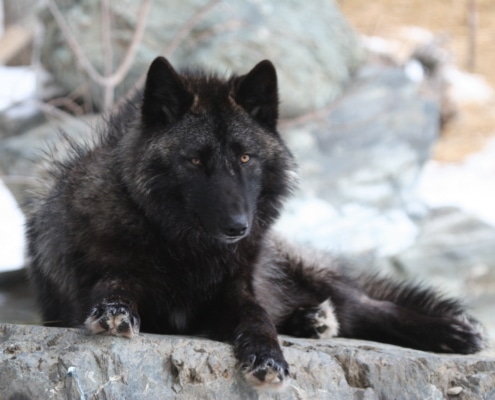
Nyssa was born on May 12, 2004. She was a black color phase of the gray wolf and was a cousin to Maya and Grizzer. While she was a week younger than her 2004 pup mates, she had an intensity that left the wolf care team members in awe. One particular moment occurred when Nyssa was about one month of age. Even though she was still on the bottle and just starting to eat ground meat, a team member set her by a deer carcass that was thawing for the adults. Nyssa grabbed onto the ear of the deer and let out a threat display, lip curl, and growl that made even the most seasoned pup team member pause. With all of our “Gone but not Forgotten” wolves, we select one word or phrase that characterizes the most memories about their life. For Nyssa, we chose “Intense”, not just for this food possession encounter, but the many behavioral observations of this pup that was perceived by many to be vulnerable due to her age difference. She definitely taught the lesson that attitude can overcome size.
Per Center management protocol, Maya and Nyssa were spayed on May 6, 2005. While the management plan had recommended confining the females from the exhibit until sutures were removed, the separation from the pack was causing a significant amount of stress and anxiety from the young females. As with any wolf management situation, risk assessment is an ongoing process, and the choice was made to reunite the pack. The pack calmed down with the return of their members, but something happened in the early morning of May 11, 2005. Upon arrival for the 8:30 a.m. wolf check, the team noticed Nyssa was lying in the sternal position and wouldn’t come to the fence for her vitamin, an unusual occurrence for a wolf that was no stranger to food. The remainder of the pack was locked into an adjacent holding area. After a thorough examination, it was determined that she had an inch of her spay incision opened, called a wound dehiscence. The team rushed her to the vet clinic and discovered internal damage beyond repair and the damage left no options but euthanasia. This is a tragic event in our wolf care history, and the legacy of Nyssa is evident with all female reproductive management that has occurred since 2005.
The events of May 11 stand as a reminder of the instinctual social dynamics that dictate life in a wolf pack. They were wolves in a world that was clearly run by wolf rules. It may never be known what triggered the events of this incident. Natural wolf behavior includes a rank order with dominant wolves aggressively forcing lower wolves to submit. Nyssa was the lowest-ranking wolf in the pack, with Maya actively showing her status as more dominant. Wolf-on-wolf aggression is one of the top two causes of natural mortality to wolves in the wild. Wolves compete aggressively for dominance, territory, access to food, and opportunities to breed. Most of the time, but not always, the aggression is ritualized to avoid serious injury, but if some factor heightens the aggression, wolf fights can be fatal.
The Center’s exhibit is unique compared to other facilities due to the proximity of wild wolves. Several staff observed a wild wolf crossing the highway in front of the Center, within days of the incident. Wolves are very territorial; the presence of another strange adult wolf on site would likely agitate the ambassador wolves, combined with the inability to deal with the threat due to fencing, the wolves could have redirected to the lowest pack member. The philosophy of the Center is to Teach the World about Wolves. The actions of the Exhibit Pack continue to do just that.
For more information on our ambassador wolves, watch extended wolf videos on the International Wolf Center’s YouTube Channel or enjoy a close-up of wolf behavior on our Wolf Watch Cams.

The International Wolf Center uses science-based education to teach and inspire the world about wolves, their ecology, and the wolf-human relationship.
